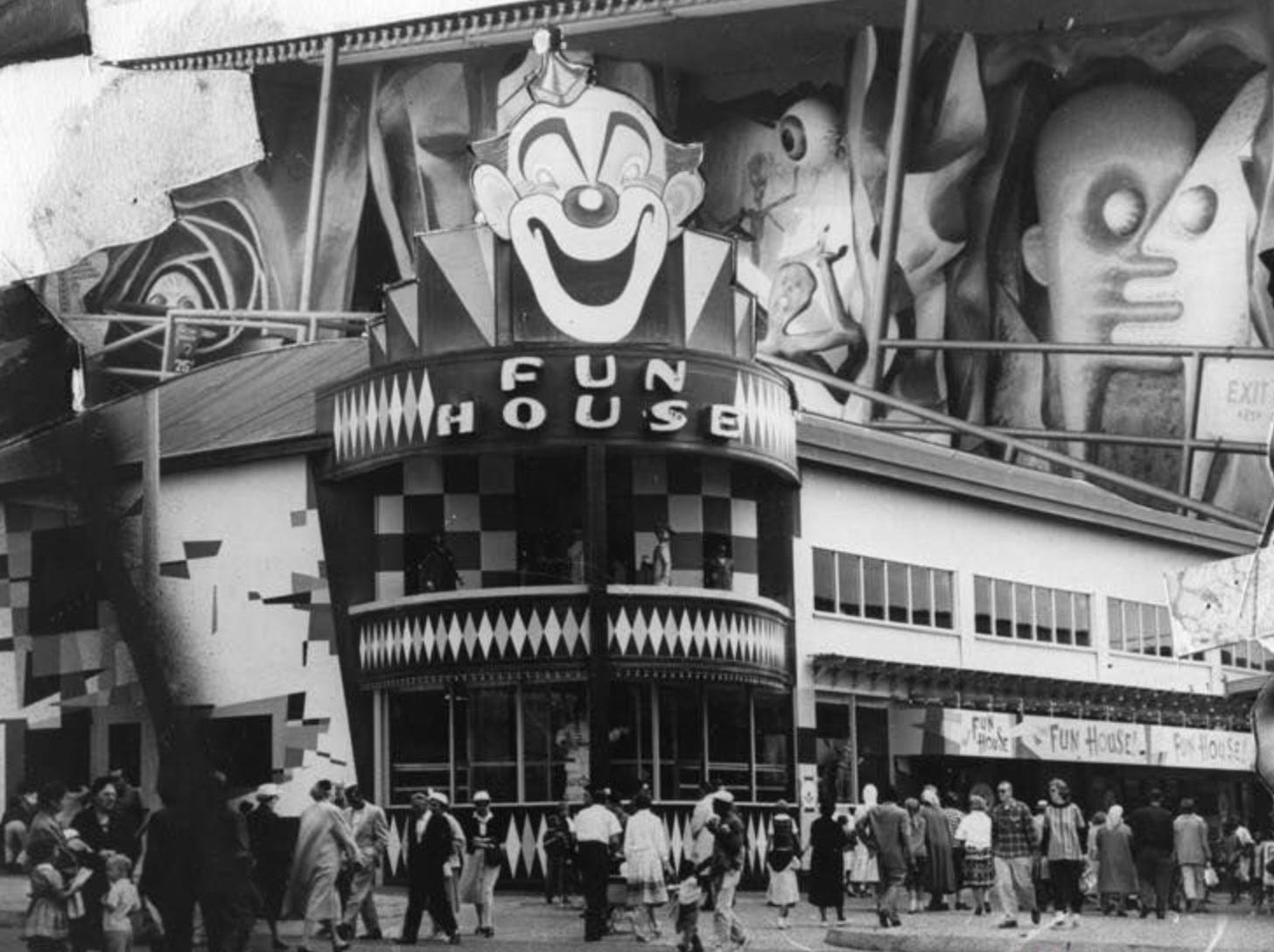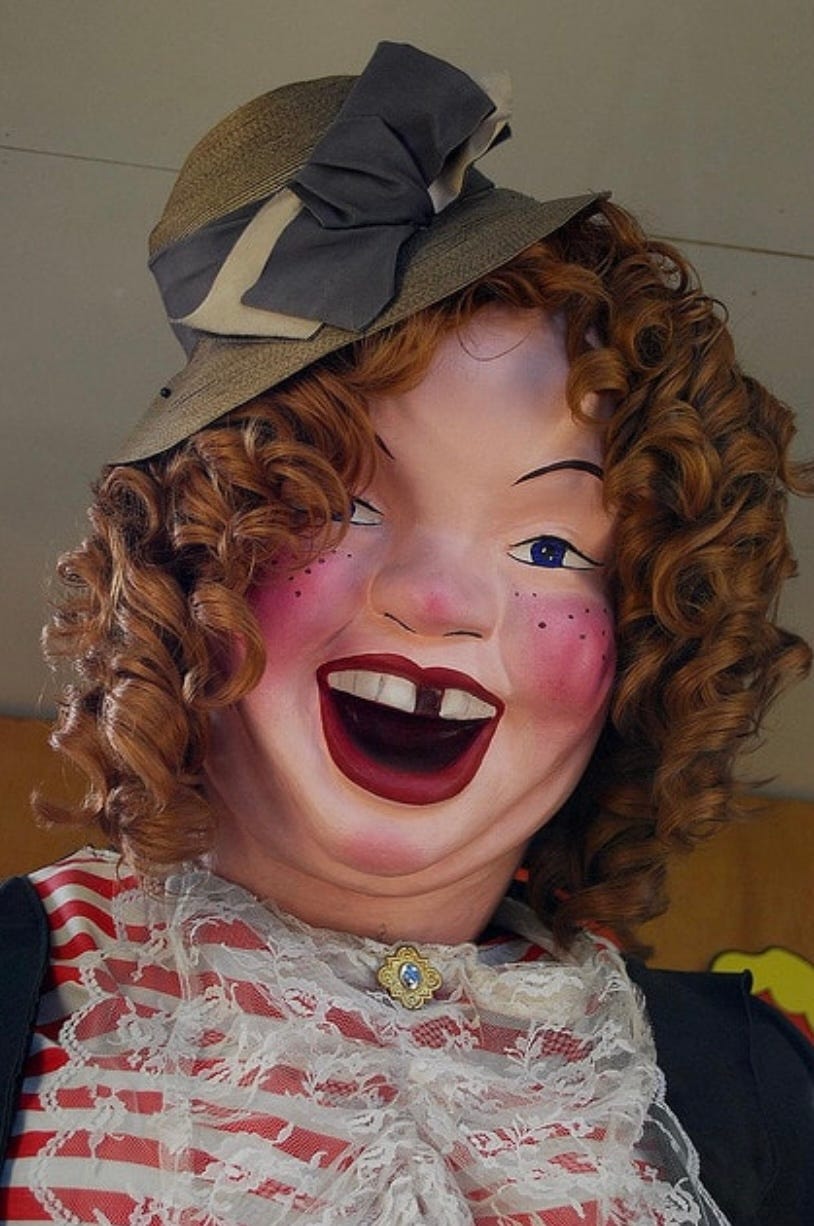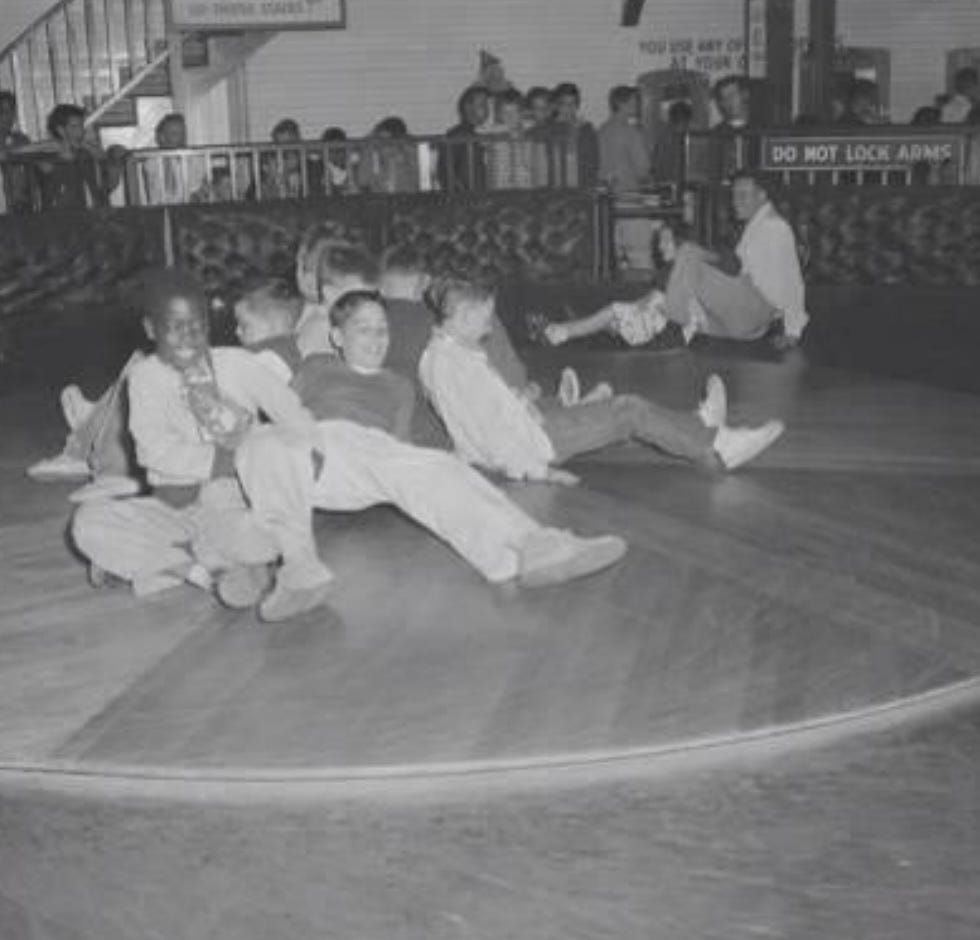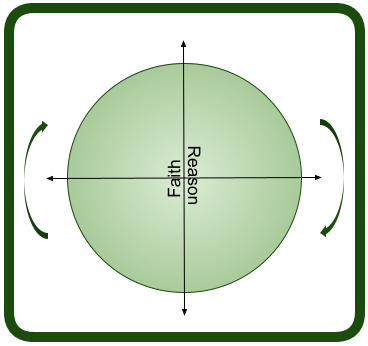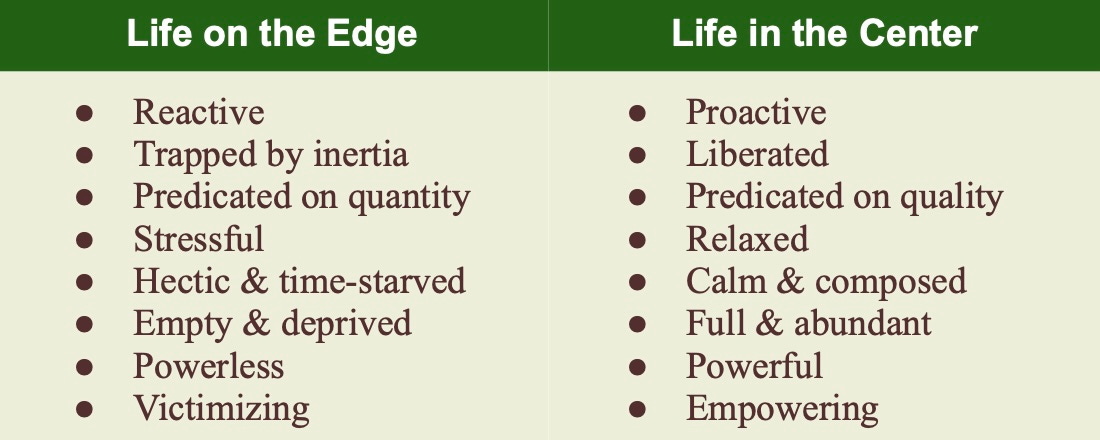Intro to the Centrifugal Map
The world's only relationship diagnosis and repair tool...
“The law of centrifugal force seems to be as true for the human condition as it is for the Newtonian mechanics. The faster our lives spin, the more things tend to fly apart.” ― Richard Paul Evans
I remember my first childhood trips with my father to the Fun House at Playland at the Beach in San Francisco, now more than sixty years ago. I remember the carnival lights, sounds, smells, and flavors like they happened yesterday — still vivid and visceral. I remember the salt air, sharp and sweet, and how little scrap piles of kelp sometimes washed up on shore and glistened in the midday summer sun like an amber necklace along Ocean Beach. I remember the damp and piercing chill of the morning and late afternoon fog as it lingered and cleansed, and the distant roar of the Pacific just across the asphalt ribbons of the Great Highway. I remember Laffing Sal…
…a larger-than-life female automaton whose grotesque visage and cackling laugh presided over the entrance to the Fun House for decades. I remember how my father’s eyes widened when he saw her, and how his face brightened, the slumbering child inside him suddenly reawakened and ready to play.
And I remember one Fun House ride in particular: the Joy Wheel, a huge wooden turntable that hovered just above a worn floor. I remember how we all scrambled aboard and plastered ourselves to the great polished disk like animated frescoes, chattering in anxious anticipation. I remember the hum as the motor came alive beneath us and the wheel started to turn, slowly at first, then accelerating, faster and faster, until those still clinging to it in extremis suddenly flew off in all directions — screaming in delight. And of course, no one got hurt…
IN the off-chance you haven’t already, please make a donation pledge to support my work here at the Quality of Life Resistance Movement. My creditors will thank you. And so will I — in advance: THANK YOU!
Fade out and fade in, now six decades later: Playland at the Beach in San Francisco is gone, long ago demolished and auctioned off. Some things remain, however: the roar of the Pacific, Ocean Beach, the Great Highway, the fog, the chill, the salt air, and — of course — the memories.
More than three decades after my childhood trips with my father to Playland at the Beach — in the midst of the Dot Com Era, deep in the heart of NYC’s Silicon Alley — it occurred to me one day that life in the late 20th-century was very much like the Joy Wheel ride of my childhood, very much like the polished spinning disk in the Fun House. The human centrifuge of my imagination, however, runs 24/7, day after day, month after month, year after year. It never stops. It never even slows down. In fact, it accelerates with each revolution. The centrifugal force and inertia we encounter on it continually increase, and there’s no padding to break our fall when we get tossed off; everyone who gets tossed off gets hurt…
Our lives are woven as a rich and complex tapestry of relationships: relationships with higher powers like God and nature, relationships with work, relationships with each other, relationships with our own minds and bodies, relationships with food, relationships with art, and — mostly notably in what I call the Great Age of Addiction — relationships with our obsessions and addictions. Perhaps hundreds of relationships over the course of a lifetime. We invest all our faith, time, and money in relationship to someone or something. Accordingly…
The quality of life is a function of how and where and with whom we invest our faith, our time, and our money.
The Centrifugal Map that evolved from my boyhood trips to Playland at the Beach is — as far as I know — the only relationship diagnosis and repair tool you’ll likely ever encounter. It was designed to help us quickly and easily identify and isolate the problem areas — and opportunities — within any relationship in our lives.
It works under the simple assertion that we can’t deal with what we can’t see, and the further assertion that the sheer proliferation of relationships — personal and institutional — in modern 21st century society leaves precious little time to take a good hard look at the actual quality of our lives. Because it was designed to honor our time and attention, the Centrifugal Map generates instant graphic representations of how well any given relationship satisfies our basic needs, and which of our inborn abilities are best brought to bear to satisfy them.
In short, the Centrifugal Map makes the invisible visible by graphically mapping the problem areas and in each relationship. And whenever we turn our attention to the problems in our lives, that’s when we discover the opportunities that await us…
It’s time to introduce you to the Centrifugal Map…
Yup, it’s that simple. The curved arrows on either side of the Centrifugal Map remind us that the human centrifuge is always spinning, while the black arrows that bisect the wheel horizontally and vertically represent the centrifugal force exerted outward from the center in all directions by the spinning wheel. To properly invoke the human centrifuge as a metaphor for modern life, however, we need to consider three things:
That the wheel always spins and never slows down for anyone.
Our job is to withstand the centrifugal force and remain on the wheel at all costs. And if we get tossed off, as sometimes happens, we must climb back on again, irrespective of any injuries or scars we may sustain in the process.In the absence of countervailing forces or actions, we will always drift by default towards the wheel’s outer edge.
The centrifugal force generated by the human centrifuge is inexorable, and will always act to nudge us outward towards the edge. It therefore doesn’t matter which way the wheel turns: clockwise, counterclockwise, liberal, conservative, Democrat, Republican, Christian, Muslim, Jew, Buddhist, Hindu, black, white, brown, yellow, straight, gay, or whatever — the physics that govern the wheel are ordained from above, constant and inviolate.Where we are on the Centrifugal Map at any given point in time will determine the quality of our lives at that moment. Albert Einstein once observed that the outer edge of a phonograph record spins faster than the hub at the center. The same is true of the human centrifuge and the Centrifugal Map: In general, life seems easier and less stressful towards the center of the wheel where there is less centrifugal force to battle, harder and more stressful towards the outer edge where the centrifugal force is greatest. So not only is it important to stay on the wheel, but also to position ourselves as close to the center as possible.
The first two conditions above qualify as force majeure, acts of God, things over which we exert no control whatsoever — no matter how hard we try. Simply stated, the human centrifuge will always spin, and will always generate centrifugal force outward from the center as a default condition, irrespective of our behavior. Only the third condition — where we position ourselves on the wheel — is subject in some measure to our own influence.
So let’s examine how our position on the wheel affects the quality of our lives, starting from the outer edge then working our way inward. Remember while we do so, however, that our lives are works in progress, and that our position on the human centrifuge and Centrifugal Map can change from day to day, or even from moment to moment, depending on circumstances and the choices we make.
Life on the Edge of the Human Centrifuge…
All of us spend time (often far more than we’d like) on the outer edge of the human centrifuge. Indeed, life on the edge is a common circumstance in what I call the Great Age of Addiction, a time when state-sponsored default addiction is the rule rather than the exception.
Addiction aside, however, our paths through life are strewn with the bones and roadside markers of lost loved ones, failed businesses, divorce, unemployment, violence, financial problems and legal hassles. These and other Black Swan events rattle our cages, knock us upside the head, and loosen our grips on the wheel. And sometimes — weary from the day-to-day attrition of the battle just to stay on the wheel — we close our eyes to steal a moment or two of blissful quiet, then wake with a start to find ourselves suddenly drifting right back out towards the edge again. Out there, out where the storm winds blow, we have no time to lick our wounds, and simply brace ourselves for the next storm. But that’s life on the edge.
Remember…
The quality of life is a function of how and where and with whom we invest our faith, our time, and our money.
In the Great Age of Addiction, much of our time is spent on the edge of the human centrifuge in default reaction to the pressures and demands — the centrifugal force — encountered in extreme environments under extreme conditions. It may not feel that way because we are now so immersed, cradle-to-grave, in a culture that can only be sustained by a constant supply of high-octane narcotics — especially those supplied by our own digital devices. It may not feel that way because we live in a perpetual dopamine-induced stupor, somatized by the things we love like the citizens of Huxley’s Brave New World. It feels normal and not extreme only because we are told 24/7 how normal and not extreme it is — and because just about everyone around us is addicted also.
Of course, extreme environments leave little or no time to contemplate right or wrong, little or no time to ponder healthy versus unhealthy or sacred versus profane. All while our state-sponsored default addiction to all things media and all things digital tells us in no uncertain terms how normal it is for the average citizen to consume 10-15 hours of digital media each and every day. Because, of course, nowadays it is. Stay tuned, they tell us…
Life on the edge of the human centrifuge is where we find ourselves when the massive inertia generated by state-sponsored default addiction combines with the intense centrifugal force at the edge of the human centrifuge. Together they conspire to prevent us from moving inward towards the center of the wheel where the quality of life is much less stressful and much more liberated.
Life on the edge of the human centrifuge keeps us mired in the stressful minutiae and technology-driven exigencies of day-to-day 21st-century life. It demands that we spend nearly all of our time just reacting to our environment, just fighting to stay on the wheel while we struggle to feed and sustain our obsessions and addictions.
But time and energy devoted to the struggle to feed our obsessions and addictions in life on the edge is time and energy diverted away from and borrowed against the quality of life. And of course we cannot afford to borrow indefinitely…
The quality of life — like all credit lines — is finite.
The daily skirmishes and battles with our obsessions and addictions carve the harsh landscape, the rollercoaster ups and downs, of life on the edge in the Great Age of Addiction. The maintenance and support of our narcotic-induced fealties in the Great Age of Addiction consume almost all of our waking time. Of course no amount of talent, money, or good will can improve our position on the human centrifuge in the absence of time — and we can’t buy, borrow, or steal more time. Once gone, it’s gone forever. And therein resides the real dilemma…
In the Great Age of Addiction life on the edge seems full of just about everything except time — and peace of mind.
Life on the edge is where most of our waking time and much of our money is spent in fealty to our state-sponsored meta-addiction to all things media and all things digital. Tragically, our faith in anything except the power of our own narcotics has been all but orphaned in the exchange — by design. In the end, the totalitarian state cannot and will not tolerate faith in anything except itself.
Ultimately, our state-sponsored default addictions imprison and enslave us. Life on the edge in the Great Age of Addiction keeps us thoroughly entertained and thoroughly mesmerized by high-definition and surround-sound technologies wherever we go and whenever we want them. But they also keep us thoroughly immersed in the glittering gulags of our own obsessions and addictions. Life on the edge keeps us mired in perpetual reaction to perpetual manufactured crises.
Life in Transition on the Human Centrifuge…
While we have no choice but to remain on the human centrifuge, we are called upon nevertheless to make the daily decisions that — in no small measure — determine our position on it. Free will is a muscle we need to exercise; otherwise the human centrifuge will always choose for us.
Functionally, the choices we make — minute by minute, hour by hour, and day by day — either help keep us where we are on the human centrifuge, combine with circumstance to move us closer to the outer edge, or combine with circumstance to move us closer to the center.
Our predisposition to choose in ways that promote either the quality of life or our obsessions and addictions depends largely on where we are positioned on the wheel at the time we make our choices.
Obsessive-compulsive behavior aside, we are very much creatures of habit to begin with, and all behaviors — good, bad, and indifferent — become easier with practice. The closer we are to the outer edge, the more likely we are to predicate our choices on convenience and quantity rather than quality, and the more likely we are to slip by default into compulsive behaviors that promote or sustain our obsessions and addictions.
Out on the edge we are far more likely to react to our environment, and far more likely to make less-considered and ill-informed choices. The longer we live life on the edge, the more difficult it becomes to imagine any other way to live. For instance, the longer we live extreme lives in single-minded pursuit of careers in extreme places like New York, Washington DC, Los Angeles, and the Silicon Valley, the more difficult it is to imagine an extreme life consumed by career ambition in extreme places as anything except normal — in no small measure because everyone around us lives the same way in the same place with the same ambitions.
Behaviors that pass as normal today in the Great Age of Addiction would have been considered insane just two or three generations ago.
Likewise, the longer we live our lives with extreme agendas in extreme places, the harder it is empathize with or even tolerate people who choose to live far less extreme lifestyles in far less extreme places. Suddenly, those who live more moderate lives are vilified as the extremists. Ultimately, protracted exposure to life on the edge inhibits courageous decisions that help us escape the prisons of our addictive behaviors, restore moderation and proportion, and reclaim the quality of our lives.
Again, it bears repeating that we are almost always in transition on the human centrifuge, almost always moving farther from or closer to the center. Our movement in either direction almost always results from a confluence of circumstance and the choices we make from moment to moment, day to day. Movement in either direction is no guarantee that we will be moving in the same direction five minutes from now.
The only guarantee is that the quality of life will improve as we move towards the center of the human centrifuge, and will deteriorate as we move towards the edge.
Life in the Center of the Human Centrifuge…
Life in the center of the human centrifuge is a liberated and conscious life predicated on the deliberate choice of quality over quantity in an environment free from the excessive behaviors of obsession and addiction — a conscious balance of faith and reason. Yet the power brokers of modern secular society tell us ad nauseum that faith and reason are polar opposites. The Big Lie looks like this…
While life in the center of the human centrifuge is antidotal to life on the edge, the two are not polar opposites. Indeed, there’s nothing whatsoever polar about the quality of life at the center of the human centrifuge. It’s in the center of the wheel for a reason…
The quality of life will always meet you halfway.
Indeed, faith and reason are complimentary prerequisites to the quality of life. Both reside in equal measure at the center of the human centrifuge…
In fact, the center of the human centrifuge is where we begin our journey in life, born in spiritual freedom with free will. The center of the human centrifuge is where spiritual freedom and free will always reside, where they always burn bright as essential life forces. The trick is to move close enough to the center of the human centrifuge to feel them at work as liberating forces in our lives.
The table below summarizes the contrasting lifestyle attributes that characterize life on the edge of the human centrifuge versus life in the center…
Take a moment to review the above table once again, then ask yourself: If the quality of my life is a function of how and where and with whom I invest my time and faith and money, how and where and with whom would I rather invest them? Which relationships in my life do a better job of protecting my spiritual, social, emotional, and physical wellbeing? Which relationships move me away from the edge and closer to the center of the wheel? And finally: How do I move myself away from the outside edge towards the center, towards the quality of life?
The Centrifugal Map not only identifies the problem areas in each relationship, but also tells us where to focus our attention to remedy those problems. Several thousand years ago, Vedic seers observed that we exhibit a tendency to become our attention, a notion since confirmed in the 20th century by subatomic physics. There is—say both the ancient mystics and the modern physicists—no actual proof of material existence. Rather, material things demonstrate only a tendency to exist, and even then only when we look for them, only when we turn our attention to them.
The Centrifugal Map makes the invisible visible by graphically mapping the problem areas in each relationship. And whenever we turn our attention to the problems in our lives, that’s when we discover the opportunities that await us…
Time to put the world’s only relationship diagnosis and repair tool to work at How to Use the Centrifugal Map. Check it out today!


